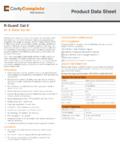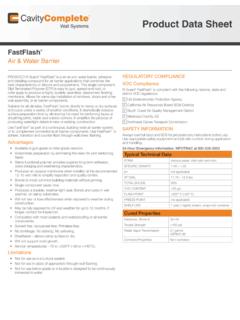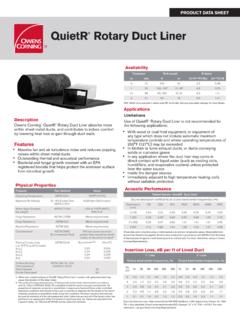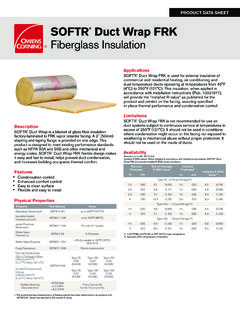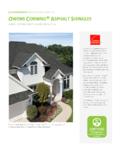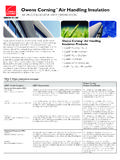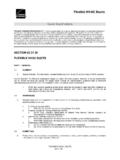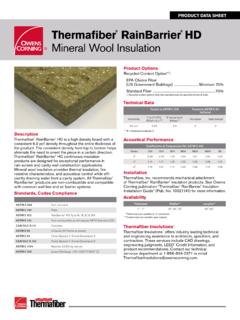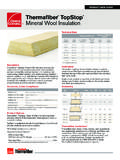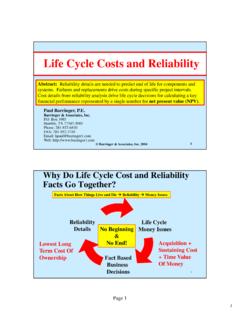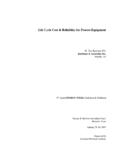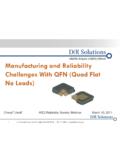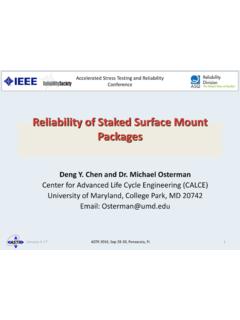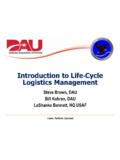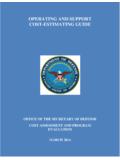Transcription of Technical Bulletin - Owens Corning
1 Technical BulletinFOAMULAR Extruded Polystyrene (XPS) InsulationSave Tomorrow s Energy Today, Specifying Optimum InsulationSave Tomorrow s Energy To d ayCurrent minimum energy conservation code requirements for commercial buildings throughout the are, in many cases, based on a recent version of ASHRAE , Energy Standard for Buildings Except Low-Rise Residential Buildings. The fi rst version of what was to become ASHRAE was published in 1975. Since then it has been updated many times due to rapid changes in building technology and energy prices. Recent updates have been published in 2004, 2007 and 2010.
2 The minimum prescribed R-values in can t change as rapidly as energy costs often do. As recently as 2004, prescribed R-values in were based on economic assumptions from 1990. Of course energy prices increased dramatically during that time period, and, prices are perhaps even more volatile today. Even though minimum prescribed R-values have been increased several times in recent editions, in your next building project, consider that, by following the minimum standard, you may be specifying today s insulation levels based on yesterday s economics! It makes sense to anticipate the future for your client, and base today s insulation levels on tomorrow s economics.
3 That is saving tomorrow s energy today. Beyond the immediate economic return of reduced energy cost, a well insulated building envelope contributes to achieving the overall goal of energy conservation on a national level as expressed in the AIA 2030 Challenge, and it acknowledges the increasing awareness of the value of sustainable design practice. All of the above is motivation to at least meet, if not exceed, the optimum insulation level. What is optimum insulation ?Optimum InsulationInsulation is an investment. Like other investments, it is expected to provide a return, or, an economic benefi t.
4 The obvious economic benefi t of insulation is that it saves energy which equals saving money. The question is, How much insulation is enough? What is the optimum amount of insulation? Optimum insulation is the amount of insulation that has the lowest life cycle cost (LCC). LCC can be expressed as:LCC = FC+M+R+E -RVLCC = Life Cycle Cost ($)FC = First Cost ($)M = Maintenance and repair cost ($)R = Replacement Cost ($)E = Energy Cost ($)RV = Resale value or salvage ($)Lowest Life Cycle CostThe concept of determining lowest life cycle cost is illustrated in Figure 1.
5 It shows fi rst cost increasing as R-value increases. Install more insulation, and the fi rst cost of insulation increases. It shows energy cost decreasing as R-value increases. Add more insulation, and energy consumption and cost decreases. The lowest life cycle cost (LCC) is the lowest sum of fi rst cost and energy cost at a given level of R-value. In this hypothetical example, R-20 is the lowest LCC, and, is therefore the optimum insulation level. This example only demonstrates the concept of optimum insulation . Actual optimum levels must be calculated for specifi c climates, specifi c building construction types, specifi c building usage patterns and specifi c economic concept of Life Cycle Cost Analysis and Optimum Insulation are utilized by ASHRAE in the development of Standard However, is a minimum standard that sometimes lags behind the upward trend of energy and construction costs, particularly when you consider that a building built today will have a useful life several decades into the future.
6 Therefore, it makes sense to anticipate the future for your client, and base today s insulation levels on tomorrow s economics. That is saving tomorrow s energy today. 024681012141605101520253035404550 Roof Insulation (R-values)Costs ($)First CostsEnergy CostsLCCF igure 1 Life Cycle Cost AnalysisTechnical BulletinFOAMULAR Extruded Polystyrene (XPS) InsulationSave Tomorrow s Energy Today, Specifying Optimum InsulationOWENS Corning FOAM INSULATION, LLCONE Owens Corning PARKWAYTOLEDO, OHIO 436591-800-GET-PINK No. 10015708. Printed in September 2011. THE PINK PANTHER & 1964-2011 Metro-Goldwyn-Mayer Studios Inc.
7 All Rights Reserved. The color PINK is a registered trademark of Owens Corning . 2011 Owens of LiabilityTechnical information contained herein is furnished without charge or obligation and is given and accepted at recipient s sole risk. Because conditions of use may vary and are beyond our control, Owens Corning makes no representation about, and is not responsible or liable for the accuracy or reliability of data associated with par ticular uses of any product described herein. Nothing contained in this Bulletin shall be considered a Standard , Energy Standard for Buildings Except Low-Rise Residential Building ; American Society of Heating, Refrigerating and Air-Conditioning Engineers, Inc (ASHRAE); 1791 Tullie Circle NE, Atlanta, GA 30329

